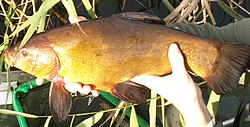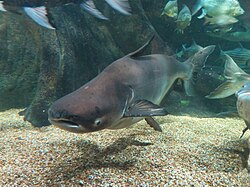Freshwater fish
This article includes a list of general references, but it lacks sufficient corresponding inline citations. (July 2021) |

Freshwater fish are
41.24% of all known species of
Physiology
Freshwater fish differ physiologically from saltwater fish in several respects. Their gills must be able to diffuse dissolved gases while keeping the electrolytes in the body fluids inside. Their scales reduce water diffusion through the skin: freshwater fish that have suffered too much scale loss will die. They also have well-developed kidneys to reclaim salts from body fluids before excretion.
Migratory fish

Many species of fish do reproduce in freshwater, but spend most of their adult lives in the sea. These are known as
Species migrating between marine and fresh waters need adaptations for both environments; when in salt water they need to keep the bodily salt concentration on a level lower than the surroundings, and vice versa. Many species solve this problem by associating different habitats with different stages of life. Both eels, anadromous salmoniform fish and the sea lamprey have different tolerances in salinity in different stages of their lives.
Classification
Salt tolerance
Freshwater fish are traditionally divided into two divisions proposed by George S. Myers in 1938:[3]
- Primary division freshwater fish are strictly limited to freshwater. They cannot survive in saltwater for any significant length of time and cannot disperse across marine water.
- Secondary division freshwater fish normally inhabit freshwater, but can survive in brackishand saltwater for some time. They may enter saltwater voluntarily and disperse across marine water.
A third group, peripheral freshwater fish, are fish which normally live in marine water but may enter and survive for some time in freshwater. This concept was introduced by John Treadwell Nichols in 1928.[3]
Temperature
Among fishers in the United States, freshwater fish species are usually classified by the water temperature in which they survive. The water temperature affects the amount of oxygen available as cold water contains more oxygen than warm water.[4]
- Coldwater fish species survive in the coldest temperatures, preferring a water temperature of 50 to 60 °F (10–16 °C).[5] In North America, air temperatures that result in sufficiently cold water temperatures are found in the northern United States, Canada, and in the southern United States at high elevation. Common coldwater fish include brook trout, rainbow trout, and brown trout.
- Coolwater fish species prefer water temperature between the coldwater and the long warmwater species, around 60 to 80 °F (16–27 °C). They are found throughout North America except for the southern portions of the United States. Common coolwater species include muskellunge, northern pike, walleye, and yellow perch.
- Warmwater fish species can survive in a wide range of conditions, preferring a water temperature around 80 °F (27 °C). Warmwater fish can survive cold winter temperatures in northern climates, but thrive in warmer water. Common warmwater fish include crappies, and many other species from the family Centrarchidae.
Status

In 2021, a group of conservation organizations estimated that one-third of the world's freshwater fish species were at risk of extinction.[6] A global assessment of freshwater fishes estimates an average decline of 83% in populations between 1970 and 2014.[7] The protection of 30% of Earth's surfaces by 2030 may encompass freshwater habitat and help protect these threatened species.[8]
There is an increasing trend in freshwater fish for local taxonomic, functional, and phylogenetic richness in more than half of the world's rivers.[8] This increase in local diversity is primarily explained by anthropogenic species introductions that compensate for or even exceed extinctions in most rivers.[9]
PFAS contamination
A study and an interactive map by
North America
About four in ten
China
About 2⁄3 of the total freshwater fisheries in China are in the Yangtze Basin.
Threats
Habitat destruction
Intentional anthropogenic reconstruction and rerouting of waterways impacts stream flow, water temperature, and more, impacting normal habitat functionality. Dams not only interrupt linear water flow and cause major geological channel shifts, but also limit the amount of water available to fishes in lakes, streams and rivers[16] and have the potential to change the trophic structure because of these alterations of the habitat and the limitations to movement and connectivity.[17][18]

Unnatural water flow below dams causes immense habitat degradation, reducing viable options for aquatic organisms. Upstream migration is hindered by the dam structure and can cause population declines as fishes don't have access to normal feeding and/or spawning grounds. Dams tend to affect upstream species richness, that is, the number of fish species in the ecological community.[16] Additionally, dams can cause the isolation of fish populations, and the lack of connectivity creates possible problems for inbreeding and low genetic diversity. The loss of connectivity impacts the structure of community assemblies and increases the fragmentation of habitats, which can compound existing problems for vulnerable species.[17]
Temperature alterations are another unintended consequence of dam and land use projects. Temperature is a vital part of aquatic ecosystem stability, so changes to stream and river water temperature can have large impacts on biotic communities. Many aquatic larvae use thermal cues to regulate their life cycles, mostly notably here, insects. Insects are a large part of most fish diets, so this can pose a great dietary problem. Temperature can cause changes in fish behavior and distribution habits as well by increasing their metabolic rates and thus their drive to spawn and feed.[17]
Linear systems are more easily fragmented and connectivity in aquatic ecosystems is vital. Freshwater fishes are particularly vulnerable to habitat destruction because they reside in small bodies of water which are often very close to human activity and thus easily polluted by trash, chemicals, waste, and other agents which are harmful to freshwater habitats.
Exotic species
An exotic (or non-native) species is defined as a species that does not naturally occur in a certain area or ecosystem. This includes eggs and other biological material associated with the species. Non-native species are considered invasive if they cause ecological or economic injury.[22]

The introduction of exotic fish species into ecosystems is a threat to many
One such example is the destruction of the endemic cichlid population in Lake Victoria via the introduction of the predatory Nile perch (Lates niloticus). Although the exact time is unknown, in the 1950s the Ugandan Game and Fisheries Department covertly introduced the Nile perch into Lake Victoria, possibly to improve sport fishing and boost the fishery. In the 1980s, the Nile perch population saw a large increase which coincided with a great increase in the value of the fishery. This surge in Nile perch numbers restructured the lake's ecology. The endemic cichlid population, known to have around 500 species, was cut almost in half. By the 1990s, only three species of sport fish were left to support the once multispecies fishery, two of which were invasive.[24] More recent research has suggested that remaining cichlids are recovering due to the recent surge in Nile perch commercial fishing, and the cichlids that are left have the greatest phenotypic plasticity and are able to react to environmental changes quickly.[25]

The introduction of the rainbow trout (Oncorhynchus mykiss) in the late 19th century resulted in the extinction of the yellowfin cutthroat trout (Oncorhynchus clarkii macdonaldi) found only in the Twin Lakes of Colorado, USA. The yellowfin cutthroat trout was discovered in 1889 and was recognized as a subspecies of the cutthroat trout (Oncorhynchus clarkii). The rainbow trout was introduced to Colorado in the 1880s. By 1903, the yellowfin cutthroat trout stopped being reported.[26] It is now presumed extinct. The rainbow trout is invasive worldwide, and there are multiple efforts to remove them from their non-native ecosystems.
Both species are among the "100 of the World’s Worst Invasive Alien Species," as determined by the IUCN Invasive Species Specialist Group based on their effect on anthropogenic activities, environmental biodiversity and their ability to act as a case study for important ecological issues.
Hybridization

Hybridization involves the mating of two genetically different species (interspecific hybridization). It is dangerous for native species to hybridize because hybrid phenotypes may have better fitness and outcompete the two parent species and/or other fishes in the ecosystem. This could irreversibly compromise the genetic identity of one or both of the parent species and even drive them to extinction if their range is limited.
The rainbow trout discussed above hybridized with the native greenback cutthroat trout (
See also
- Freshwater Biology
- Freshwater fish of Malaysia
- Freshwater fish in the Philippines
- Freshwater fish of Australia
- Freshwater fish of Barbados
- Freshwater fish of India
- Freshwater fish of Ireland
- Freshwater fish of the United States:
- Lake ecosystems
- List of common fish names
- List of fishes in Bangladesh
- List of fishes of Great Britain
- List of freshwater fishes of Greece
- List of freshwater fishes of Korea
- River ecosystems
- Saltwater fish
Sources and references
- from the original on 2021-07-03. Retrieved 2021-07-03.
- ^ "Migration - Catadromous fish". Encyclopedia Britannica. Archived from the original on 2020-08-01. Retrieved 2021-06-27.
- ^ ISBN 978-0-12350-445-6.
- ^ "Freshwater Fish Species". Archived from the original on 2020-05-23. Retrieved 2016-10-07.
- PMID 36796924.
- ^ Gland (23 February 2021). "World's forgotten fishes vital for hundreds of millions of people but one-third face extinction, warns new report". WWF. Archived from the original on 2021-02-23. Retrieved 2021-02-24.
- ^ "Global Freshwater Fish Assessment". IUCN. 2019-01-07. Archived from the original on 2021-02-28. Retrieved 2021-03-24.
- ^ from the original on 2021-03-12. Retrieved 2021-03-11.
- S2CID 52161648.
- ^ LaMotte, Sandee (17 January 2023). "Locally caught fish are full of dangerous chemicals called PFAS, study finds". CNN. Archived from the original on 14 February 2023. Retrieved 15 February 2023.
- S2CID 255248441.
- ^ "Freshwater fish in North America endangered: study". Archived from the original on 2008-09-13. Retrieved 2008-09-11.
- PMID 31149641.
- ^ Liu, J.; and Cao, W. (1992). Fish resources in the Yangtze basin and the strategy for their conservation. Resources and environment in the Yangtze Valley, 1: 17–23.
- ^ Wang, S.; and Xie, Y. (2009). China species red list. Vol. II Vertebrates – Part 1. High Education Press, Beijing, China.
- ^ doi:10.1890/03-5306. Archivedfrom the original on 2021-07-03. Retrieved 2020-04-29 – via Research Gate.
- ^ S2CID 42804805.
- ISSN 1540-9309.
- PMID 29910537.
- ISSN 1951-6401.
- ^ "How land use change affects water quality, aquatic life". ScienceDaily. Archived from the original on 2019-05-07. Retrieved 2020-04-29.
- ^ "FAQs - Invasive Species - U.S. Fish and Wildlife Service". www.fws.gov. Archived from the original on 2020-03-30. Retrieved 2020-04-29.
- S2CID 83889298.
- S2CID 13720490.
- ISSN 1708-3087.
- ^ ISBN 978-0-470-99977-6
- ^ "Cutthroat trout-rainbow trout hybridization | Rocky Mountain Research Station". www.fs.usda.gov. Archived from the original on 2021-05-24. Retrieved 2020-04-29.
- ISSN 0888-8892.
- PMID 28186104.
- PMID 28186104.
References
- Borgstrøm, Reidar & Hansen, Lars Petter (red): Fisk i ferskvann - et samspill mellom bestander, miljø og forvaltning, Landbruksforlaget 2000
- Jonsson, Bror: «Fiskene» i Norges dyr - Fiskene 1, Cappelen 1992
- Olden, J. D., Kennard, M. J., Leprieur, F., Tedesco, P. A., Winemiller, K. O., & García‐Berthou, E. (2010). "Conservation biogeography of freshwater fishes: recent progress and future challenges". Diversity and Distributions, 16 (3): 496–513.



